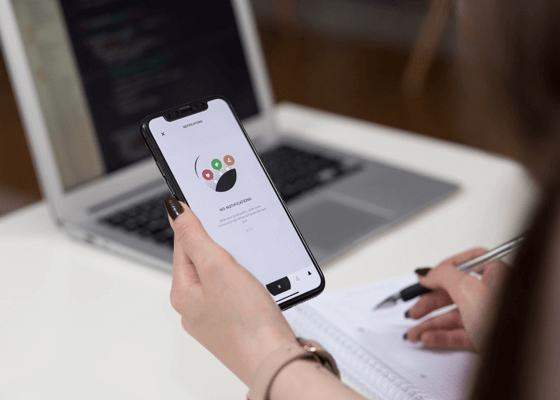Chatbots: The Future of Marketing
A Beginner’s Guide to Chat Bots
When you think of chatbot marketing, what comes to mind?
Chatbots are making serious progress for marketing, sales and support teams.
Imagine having a bot that talks to your prospect on your sales page.
Or a bot on your customer service page that answers questions for you.
Or even a Facebook messenger bot that gets 10 times the opens your email list gets, with 10 times the results.
All of it is possible with chatbots, if you know how.
First Things First
What is a chatbot?
A bot is a computer program that automates certain tasks.
And in the case of a chatbot, the task being automated is a one on one conversation with a person.
These bots range from the simple; a series of IF-THEN statements…
… to the complex; sophisticated technology like artificial intelligence and natural-language processing.
Alexa is a type of chatbot, as is the Domino’s Pizza app.
Today’s chatbots can reply with text, audio, video, images, GIFs, or just about anything else.
And even the mediums for chatbots have grown exponentially. They’re everywhere, such as the chat apps like Messenger and WhatsApp, as well as the little button in the corner of websites asking if you need any help.
For this article we’ll be talking mainly about chatbots found on social media channels.
How To Build Your Own Messenger Chatbot
Let’s answer the biggest question of all: Do you need to be a programmer to create your own chatbot?
Absolutely not anymore. Now there are all kinds of services that help you build your own chatbot without any programming skills.
And many of these tools are easy to set up – you just choose your IF-THEN sequence and test it out:
Here are several of the more popular chatbot services:
OnSequel https://www.onsequel.com/
Chatfuel https://chatfuel.com/
Botsify https://botsify.com/
Mobile Monkey https://mobilemonkey.com/
FlowXO https://flowxo.com/
Facebook Messenger’s official page offers to build your own bot directly through the platform’s landing page. This method though, may be a little bit more complicated than others. https://developers.facebook.com/products/messenger/
10 Tips for Building Your Own Successful Chatbot
1: Research
Consider what your bot is going to do and then research to find out how it will work.
For example, if the chatbot is going to answer product or customer service questions, then look through your data and find out what your most frequently asked questions are.
Customer service chatbots are a real time saver, since they can usually answer 80% of customer questions for you in real time. Imagine if 80% of your customer service requests were handled automatically, without a real human having to touch it. What would that mean for your time, or the time of your virtual assistants?
To create a customer service bot, look at the most frequently asked questions for your product or service to see what content makes sense to begin with.
To find these FAQs, you might ask your customer service team or poor through the questions you’ve personally answered. You’re looking for the questions that come up time and time again.
Look at the questions asked on social media, too. Anyone on your staff who interacts with your customers is someone who can help you assemble your FAQ.
If you have a sales team, be sure to consult them. And even take a look at the questions you’ve strived to answer through social media and content marketing.
If you want to go even further, you can source questions from outside your immediate website, products and team. The search suggestions at the bottom of relevant Google pages are a good place to start, as are crowdsourced communities like Quora and Reddit.
If you’re building a chatbot to help with sales, to generate leads or to promote any product or service, it’s crucial to research common questions and customer journeys so your bot is fully prepared to be as useful as possible.
2: Conversation Tree
You’re going to build your bot its very own conversation tree.
Chatbots work best when given a concrete set of questions to answer. It takes a good amount of specificity and pre-planning to get this right. Otherwise the chatbot will deliver a less than believable experience and perhaps even give the wrong answer.
But this is why a conversation tree works so well.
Picture a gigantic flowchart or a mindmap.
Beginning with the first hello from the bot along with its very first question for the user, you branch off from there. You’ll be building conversation flows for every different direction the conversation may turn.
You can use tools such as Lucidcharts and Whimsical for creating easy-to-read flowcharts that will make this project much easier for you and your team.
3: Avoid fully open-ended conversations
Bots can get confused, and open-ended conversations can lead to a poor experience for the user. If your bot doesn’t have highly-advanced language processing, then an open-ended question like “How can we help you today?” may or may not work. Frankly, it could wind up going in a direction you don’t even predict.
If you take a look at Hello Fresh in Facebook Messenger, you’ll see that among the bot’s first messages to the user is an offering of a menu of choices: “Here are some common questions I can answer” Options include things like:
- How does it work?
- What does it cost?
- Are you gluten-free?
- Are you vegan?
- Give me a discount!
The user chooses any of these statements by tapping on them in the Messenger interface. Then the bot responds with an automated reply.
This method is the safest route to take and removes the guesswork from the bot’s replies since it knows exactly what to say, depending on which message it receives.
4: Let people know that a human is available
You might think that people don’t like chatbots, but that’s not true. In fact, 69% of consumers prefer communicating with chatbots compared to in-app support, most likely because people love speedy answers to their problems.
Of course, that also means that 31% of consumers might prefer the old-fashioned way — email or social support.
But this can be added into your bot experience, too.
You have the option of simply letting people know as part of the bot’s welcome messages that the user is invited to get in touch with a human at any time.
5: Give your bot the right voice
Your brand has a voice and tone, and your bot can be a natural extension of that same voice and tone. Look at the way your posts are written and use that same style when deciding what your bot will say. This consistency will create a seamless experience for your users, making them feel comfortable and at ease.
Another option, which I don’t recommend, is to lean into the “bot-ness” by making the voice a bit more obviously robotic. Many companies do this, although I have figured out why.
Whatever you choose is entirely up to you. Just stay consistent with it throughout your conversation tree.
Your opening message is key. Use your voice and tone to be welcoming and put the user at immediate ease.
And be sure to let users know they can get in touch with a human at any time. That’s a great nugget to place into your bot’s welcome message.
Also include things like:
- A catchy hello.
- Expectation-setting. Letting people know they’re talking with a bot.
- And a solid first question with plenty of options to capture as many possible user journeys as you can.
6: Track the effectiveness of your bot
One of your biggest questions will be… is this chatbot working?
That depends, because “working” can mean a lot of different things.
If you’re using chatbots to reduce your customer support volume, then that’s an easy metric to track.
If you want to measure the effectiveness of marketing or sales, then it can be invaluable to track the bot’s success with measurable links and codes.
For example, you can include the word “bot” right in your coupon code (for example: BotCoupon25).
And you can do this with your UTM codes for the content you link from your bot. (A UTM code is a simple code that you can attach to a custom URL in order to track a source, medium, and campaign name.)
Give it a UTM source of chatbot and you can measure the clicks and traffic that come from the bot, as well as track the UTM all the way through your customer journey.
You may even end up measuring ROI from the bot and learn how well your investment is paying off.
7: Replace email newsletters with chatbot newsletters
You’ve probably got a good idea of how great a chatbot can be for incoming requests.
But how about outbound? There is a lot of room to experiment here. And while you might hesitate to do this if it seems too strange or new, one of the prime places is using your bot as a content delivery system.
For instance, on Facebook Messenger, any time someone talks to you through Messenger, they are added to your contact list.
You can set up a chat bot to ask these folks to opt in to hear regular updates and announcements from you, then — voila! — you’ve just built a subscriber list on your messenger bot.
Tools like Mobile Monkey can then make it easy to send out new blog posts or quick information to this group.
Some estimates say that chatbot newsletters generate a 70-80% engagement rate.
- Send surveys to your contacts
Do you want to pick your prospects brains? With the high engagement rate of bots, you also have a good chance of getting your message noticed and acted upon for surveys.
As you know, it can be difficult to survey folks via email or on a website or app. You just don’t get that many responses. But it’s a bit easier with bots.
With surveys, you first ask people to opt in to hear from you and then you can message them occasionally with a short and simple survey.
Many of the tools we mentioned earlier include the option for two button-based responses, which are perfectly suited for the mobile-first experiences of social media bots.
- Take your bot to the next level
Check out this list of powerful chatbot superpowers:
- Theme parks tell you the wait time for rides
- Hotels can tell you room availability
- Booking sites tell you the best options for your dates and your price range
- Food delivery places let you order
These are all possible because of the Big Data that these brands use in their bots.
But if you’re not at this level yet, that’s okay.
You can get started by anticipating the most common customer questions and doing your best to fill in your bot with details.
Simple things like hours of operations, daily deals, etc. can make for a delightful experience.
And if you do have a customer base who clamors for data-rich answers, then use the examples above to inspire your chatbot dreams.
You might also personalize your chat experience with variables like first names or locations.
- Promote your chatbot
This one might seem obvious, but it’s perhaps one of the most important tips we’ve covered so far.
Your bot will only be successful if people find it and use it, so get the word out and tell everyone.
This might happen organically as people visit your Facebook page and are routed to you on Messenger, or you can be proactive about it.
For example, you might mention your bot in a list of all your customer support channels
You can add a call-to-action on your blog or website to get in touch with you
And you might advertise on social for people to opt-in to your bot experience.
Bottom Line: If you’re not using chatbots yet, you might be missing out on time saved, goodwill built and sales made. Chatbots aren’t the future anymore, they’re the present, and if used correctly they can do wonders for your business.

















